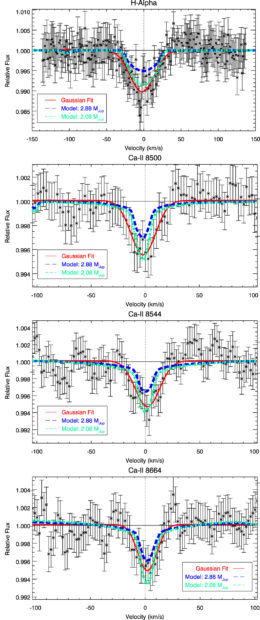As the ultra-hot Jupiter KELT-9b blazes across the face of its host star, we have an excellent opportunity to examine its scalding atmosphere. A new study now reports on what we’ve found.
A Passing Glance
In our efforts to learn more about worlds beyond our solar system, atmospheres provide a critical key. Characterizing the atmospheres of exoplanets can provide us with insight into the planets’ compositions and climates, their evolution, and even — with some potential caveats — their habitability.

As a star’s light filters through a planet’s atmosphere on its way to Earth, the atmosphere absorbs certain wavelengths depending on its composition. [European Southern Observatory]
In a new study led by Jake Turner (Cornell University), a team of scientists digs deep into such a transmission spectrum for the exoplanet KELT-9b.
Not Exactly Temperate
KELT-9b is an extreme world. Clocking in with a dayside temperature of more than 4,500 K (~7,600 °F), it is the hottest planet known — hotter than many stars! This ultra-hot Jupiter orbits at a mere 0.035 AU from its scalding A- or B-type host star, whizzing around its host in just 1.5 days.
The intense radiation bombarding KELT-9b almost certainly takes a toll: this energetic light should dissociate molecules into their component atoms and ionize metals in the hot atmosphere, and it may inflate the envelope of hydrogen gas around the planet to the point where the hot gas escapes.

Observed and modeled Hα (top) and Ca II (bottom three) spectral lines in the atmosphere of the ultra-hot Jupiter KELT-9b. [Adapted from Turner et al. 2020]
Detecting Atmospheric Thermometers
The authors find absorption lines indicating the presence of ionized calcium, Ca II, in KELT-9b’s atmospheric spectra; this is just the second time that Ca II has been observed in a hot Jupiter’s atmosphere. They also find prominent Hα absorption — evidence that confirms the existence of an extended envelope of hydrogen surrounding the irradiated planet.
By modeling the spectra they obtain for KELT-9b, Turner and collaborators are able to identify the pressures, altitudes, and temperatures at which these spectral lines form in the atmosphere. They find that the Ca II lines probe the atmosphere at an altitude of about 1.32–1.40 times the planet’s radius. The Hα line provides information from higher up, at 1.44 planetary radii.
Together, these absorption lines act as atmospheric thermometers, providing a picture of KELT-9b’s atmospheric temperature profile and yielding insight into the energy that enters and leaves the planet’s atmosphere.
These results demonstrate the power of this technique, revealing the remarkable wealth of information we can glean from some distant starlight filtered through the atmosphere of an extreme world.
Citation
“Detection of Ionized Calcium in the Atmosphere of the Ultra-hot Jupiter KELT-9b,” Jake D. Turner et al 2020 ApJL 888 L13. doi:10.3847/2041-8213/ab60a9

4 Comments
Pingback: SPACE TODAY
Pingback: Estudando de Forma Detalhada a Atmosfera do KELT-9b – O Exoplaneta Mais Quente Conhecido | Mestre Jedi
Pingback: Zaglądając w atmosferę najgorętszej znanej planety – PTMA Kraków
Pingback: 1,000 AAS Nova Highlights and Five Years of Astronomy